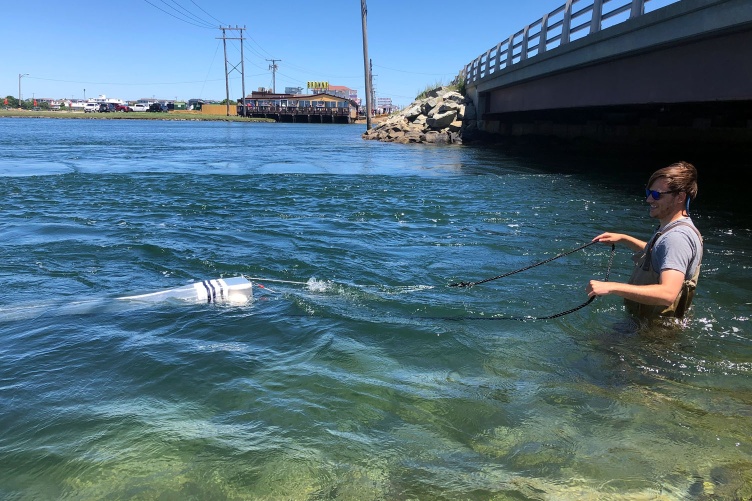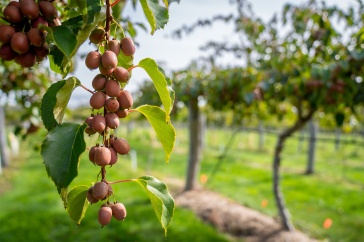Key Research Finding
In northern New England estuaries, microplastics accumulate likeliest in areas with weaker water flow, submerged vegetation and limited seabed erosion.
Nicknamed 'nurseries of the sea,' estuaries provide critical nesting and breeding grounds for many animal species, help clean and filter ocean waters and support a growing shellfish aquaculture sector in northern New England. They have also increasingly begun to play a central role in the movement of microplastics between fresh and saltwater watersheds, with potential implications on the resilience of plants, animals and economies that rely on healthy estuarine ecosystems. To determine the extent to which microplastics could impact New England estuaries first requires an understanding of how these tiny particles move and accumulate throughout the waterbody—a main research goal of scientists at the University of New Hampshire.
Researchers working on this issue include New Hampshire Agricultural Experiment Station scientist Bonnie Brown, professor and chair of the department of biological sciences, and Gregg Moore, associate professor of coastal restoration and resilience, both in the UNH College of Life Sciences and Agriculture (COLSA). They are investigating the accumulation of microplastics within some of the region’s most important estuarine environments: New Hampshire’s Great Bay, the Hampton-Seabrook estuary and New England’s largest salt marsh, the Great Marsh in Massachusetts. They hope the data they gather help develop predictive models that can indicate where and when the greatest concentrations of microplastics will occur, potentially offering guidance to recreational and commercial fishermen and seafood farmers on how areas with high concentrations of microplastics.
“Our data are being used in models created to determine where the microplastics originated, where they settle — if they do — and how long it takes for them to leave the ecosystem,” explained Brown. “Knowing the types and locations of microplastics allows us to evaluate the realistic levels of risk that estuarine microplastics pose in New Hampshire and northern Massachusetts estuaries and to help resource users and managers, including aquaculturists, fishers and recreationalists, all of whom depend on these estuarine environments, to understand the origin and fate of microplastics.”
While research is nascent about their impacts on human and animal health, microplastics—pieces of plastic smaller than 0.04 inches (roughly the size of a medium-sized grain of sand and smaller)—represent potentially serious threats. In freshwater and saltwater habitats, they can particularly impact fishing and aquaculture industries. For example, in a study of 11 different species of fish found in Lake Michigan tributaries, 85% of the fish studied contained microplastics. To better understand where microplastic risks are highest, Brown, Moore and researchers from both of their labs recently published a study examining the distribution of microplastics in the three estuarine environments, offering a model for the sources, movement through the watershed and the final locations of the particles. Their paper was published in Water Emerging Contaminants and Nanoplastics.
The findings show that microplastics accumulate in areas with weaker water flow, submerged vegetation and limited seabed erosion. The researchers also determined that the Hampton-Seabrook estuary, the smallest estuary sampled, had a significantly higher number of microplastics than the other two estuaries, likely due to the rapid flushing of water from the larger estuarine environments. Another important outcome, according to Taja Sims-Harper, a doctoral student in COLSA’s marine biology program, was establishing a baseline for comparing ambient levels of microplastics in our estuaries.
“With this information, realistic numbers of microplastics can be used in our experiments on the uptake and elimination of microplastics from aquatic living resources,” Sims-Harper added. “Additionally, despite us using multiple different sampling methods (each with its own limitations), our set of studies offered a remarkably consistent baseline for the presence and types of microplastics in these New England estuaries.”
According to Moore, natural coastal habitats often trap and retain microplastics. However, it’s not clear how much of these plastics remain within these habitats, nor what their potential impact could be.
“In the same way that native marsh grasses buffer coastal energy to trap suspended sediments in tidal waters, this mechanism also traps suspended microplastics,” he said. “While perhaps unintentional, this natural process may help bury microplastics for most, but not all, biological processes.”
However, it’s not clear how much of these plastics remain within these habitats nor what their potential impact could be.
“More importantly, we do not know how these plastics may affect the living organisms in them or the more abiotic ecosystem components like the water or soil,” Moore added. “We need to determine which estuaries, and which habitats within them, capture the most microplastics.”
This latest research complements Brown and Moore’s previous modeling collaboration with Tom Lippmann, a professor of Earth sciences and ocean engineering with UNH’s College of Engineering and Physical Sciences, on microplastics in the sediment at Great Bay’s bottom.
Their 2021 study indicated that more microplastics accumulate in areas where the water flow and bed shear stress (a measure of various forces, including water flow, friction and gravity, that impact sediment transport over the seafloor) are weaker, such as in eelgrass meadows and along an estuary’s edge. Using Brown’s new baseline microplastic measurements in the estuaries, the study found that microplastic variation in the estuarine waters and sediments can be attributed to several factors, such as the number of tributaries, plastic types, density of nearby human populations, storms, water depth, tides and precipitation. As more research into microplastics becomes available, modeling predictions will become more accurate and should offer a better understanding of how microplastics affect these irreplaceable ecosystems.
New Hampshire’s Great Bay Estuary is one of 28 “estuaries of national significance” in the country, according to the EPA. This 2,000-acre-plus estuary provides a key habitat for many fish and wildlife species and draws tourism with its fishing and hiking opportunities. In recent years, Great Bay Estuary has become a significant shellfish aquaculture and restoration site, with scientists and conservation agencies working together to restore hundreds of acres of oyster reefs, helping to improve water quality and kickstart native oyster growth. The health of an estuary and its tributaries are strongly connected, and Great Bay is no different. Multiple rivers drain into Great Bay, including the Lamprey, Winnicut, Squamscott, and Oyster rivers, creating a watershed spread across 1,000 square miles in southeastern New Hampshire and connecting everyone living and working in that watershed to the health of Great Bay Estuary.
Also studied, the Hampton-Seabrook Estuary is New Hampshire’s largest salt marsh and Great Marsh Estuary is New England’s largest estuary, stretching the entire length of the Massachusetts North Shore. Both these estuaries are important breeding habitats for migratory birds. Protecting these habitats—for plant and animal species that exclusively rely on estuaries; for human use; and for fisheries and aquaculture industries—is a key goal of University of New Hampshire researchers.
This material is based on work supported by the NH Agricultural Experiment Station through joint funding from the USDA National Institute of Food and Agriculture (under Hatch award number 1023564) and the state of New Hampshire. Additional support came from the UNH School of Marine Sciences and Ocean Engineering; New Hampshire Sea Grant, pursuant to National Oceanic and Atmospheric Administration Award No. NA18OAR4170090; and the Merrimack Valley Planning Commission.
To learn more about this research, read A baseline for microplastic occurrence in three New England estuaries, published in Water Emerging Contaminants & Nanoplastics.
-
Written By:
Maeve Gifford | UNH College of Life Sciences and Agriculture | Maeve.Gifford@unh.edu























































